It’s a fact that it costs three times more to attract new customers than to sell to existing ones. Yet, nearly half of all companies spend most of their marketing efforts on logo acquisition instead of upselling to their existing customer base. Current customers present an incredible opportunity to capture a competitive edge. With the right strategy, a SaaS company can extend customer lifetime value and reduce customer churn while increasing its profits. In this article, we will explore the benefits of customer marketing, its relationship to customer Success, and its difference from product marketing.
Key Points
- Customer marketing refers to any marketing activity or campaign aimed at current customers.
- Types of customers in marketing include loyal customers, discount customers, impulse customers, and need-based customers.
- The 4Cs of customer marketing are consumer, communication, cost, and convenience.
- Irrespective of how you define customer marketing, here are some of its top benefits: customer retention, customer advocacy, collaboration across departments, and increased revenue.
- The difference between product marketing and customer marketing is that it focuses on communicating about items purchased, their availability, and how they can fulfil customer needs. On the other hand, customer marketing uses data-driven customer- segments to market to customers effectively.
What Is Customer Marketing?

Customer marketing refers to any marketing activity or campaign aimed at current customers. It’s generally conducted to market additional products to your established customer base, retain customers, foster customer loyalty, and turn customers into evangelists.
Customer marketing builds loyalty and enthusiasm, hoping those elements translate into new business. In the practice context, the term “new” has multiple meanings.
“New” business could mean existing customers buying new products or services as you develop them. It could mean customers upgrading the products they currently leverage or upping the tier of your service they subscribe to. Or, and perhaps most importantly, it could mean customers being enthusiastic enough about your business to evangelize to their friends and family about how excellent your company is in attracting new customers for you.
Comparing Customer Success With Customer Marketing
Customer Success and Customer Marketing both play pivotal roles within any SaaS company. Both departments are critical to reducing customer churn and extending customer lifetime value. Customer Success concentrates on ensuring buyers achieve maximum value from their customer journey—customers can successfully reach their business goals with a company’s products and services. Customer Marketing aims to sell more products to existing customers and incentivise and reward customer advocacy.
A SaaS company often achieves the best results when these two operations work toward customer retention. In some cases, Customer Success may even helm a company’s Customer Marketing strategy. The data collected by Customer Success teams is often paramount to shaping a company’s Customer Marketing strategy. Close cooperation between these two business operations ensures that customer marketing remains focused on what’s best for the customer while allowing the company to capitalize on customers’ success.
Why Is Customer Marketing Important?

Customer marketing has gained traction as markets become increasingly flooded and companies struggle to break through the noise. By fine-tuning an exceptional, personalized customer experience, a business can retain its existing customers while hopefully attracting prospects, which is great news for revenue.
Driving down things like churn rate and powering up the average customer lifetime value means working on your existing customer base is much more cost-effective.
Tip: U.S. companies lose over 136 million dollars due to avoidable customer loss.
That’s right, a loss that could have been avoided. Returning customers are over five times more likely to repurchase and, similarly, are likely to forgive a company error, four times more likely to recommend, and seven times more likely to try out new products. Retention is crucial.
Coupled with advocacy tactics and programs, this can provide invaluable insights because customers are likelier to leave feedback and complete surveys. This gives you more information to inform strategy, feed into overall customer lifetime value, and drive expansion.
Customer marketing will also have a significant role in identifying customers for case studies or customer stories — shining the light on their successes with your brand and possibly elements of the onboarding and adoption process.
Customer marketers have such a deep understanding of their customers that tailoring these areas of the customer experience so that they’re as optimized and personal as possible is a key differentiator. It also lays the groundwork for successful product adoption and engagement. Ultimately, customer marketing grows a business.
What Are the Types of Customers in Marketing?
#1. Loyal customers
Loyal customers are customers who come to you repeatedly for products or services. These customers are worth their weight in gold and indicate when the work you’re putting in on improving your brand is hitting the right notes.
#2. Discount Customers
Consumers only buy your product or service if it’s been discounted and is not listed at its total retail price.
While difficult to manage, it isn’t impossible to manage and keep them onside—it’s all about being creative and thinking outside the box.
#3. Impulse Customers
Impulse customers don’t necessarily have pre-determined plans to purchase your product or service. Rather, their purchase is a spur-of-the-moment decision that can sometimes arise when they don’t consider buying anything.
#4. Need-Based Customers
Need-based customers’ buying decisions are influenced by a specific need. They’ll enter a store or your website knowing exactly what they want and why, make the purchase, and then leave. Because they’ve made a decision already, upselling and cross-selling to this segment of your customer base can be challenging, though not impossible.
What Are the 4Cs of Customer Marketing?
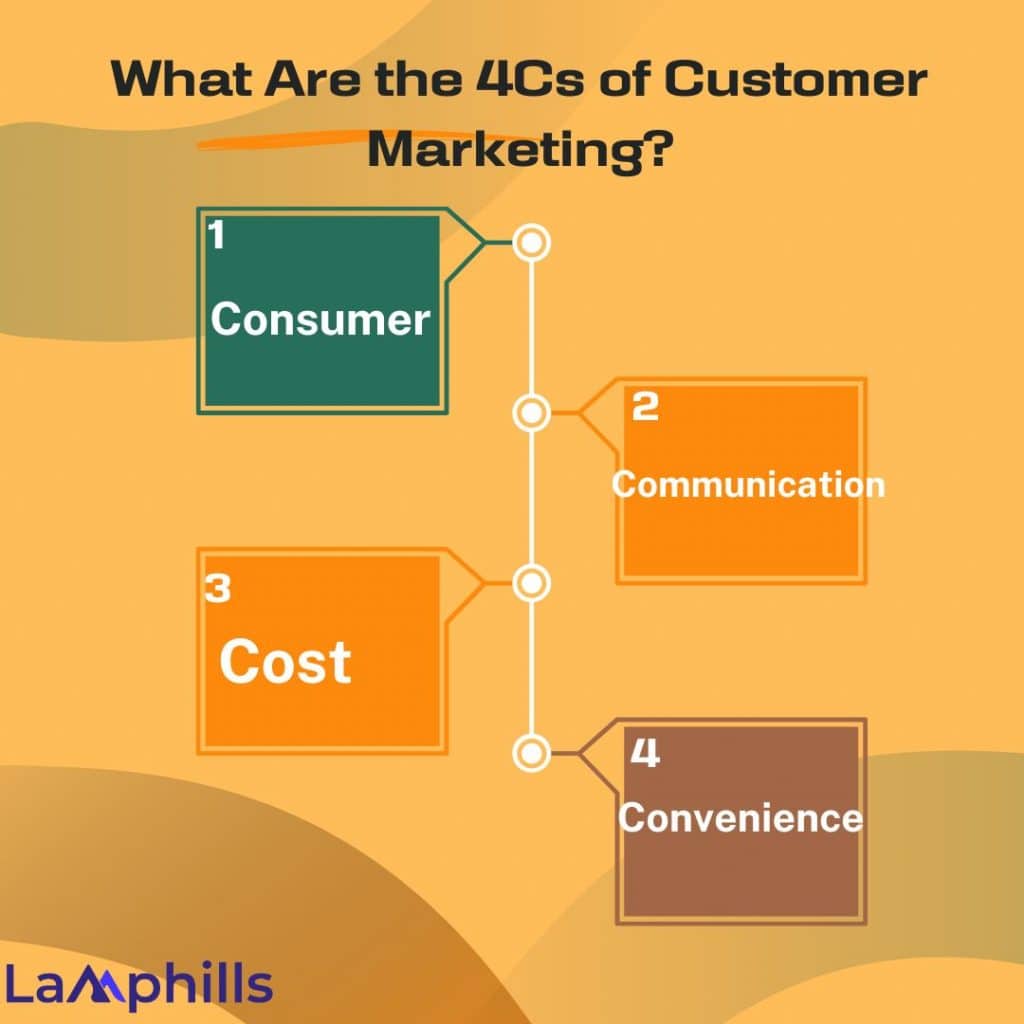
If you have ever studied marketing strategy, you have heard of the famous “4 Ps of marketing.” However, as our understanding of marketing evolves, new theoretical models emerge. The 4Cs of marketing are Consumer, Communication, Cost, and Convenience. The 4 Cs are a paradigm shift because they put the consumer rather than the brand or company at the centre. This fits much better in today’s marketing ecosystem, where customer needs are paramount and consumers have great decision-making power.
#1. Consumer
First and foremost is the consumer, who will be using the company’s products or services. Instead of focusing on the product, a company must identify the consumer’s needs and desires and design solutions.
The first step in understanding the consumer is developing a buyer persona. This is a semi-fictional representation of your brand’s ideal customer focused on his or her needs and pain points.
#2. Communication
In the 4 Ps model, product and service promotion is a key point, but this approach is too limited in today’s marketing environment since digital media facilitate continuous interaction with the customer, and this should not be exclusively promotional.
Therefore, the 4 Cs of marketing focus on communication, including all consumer and brand interactions. The focus is no longer on convincing the public about the virtues of a product or service but on providing value to potential customers. Ensure you inform customers about what your brand offers and that you can answer questions or address concerns. This can be done easily and cheaply via social networks, increasing your engagement levels on social media.
#3. Cost
Where the 4 Ps model focuses on price, the 4 Cs model extends this concept to discuss cost.
The price the customer pays for a product is only a small part of the actual cost. Consider what it takes for the customer to get the product, such as the time it takes them to get to the location where it is sold (if that is a factor).
Also, consider the product’s benefits for the customer and whether these can offset the total costs. If they don’t, consider how you can adjust your sales process to make it more customer-friendly.
#4. Convenience
The last of the 4 Cs of marketing focuses on the consumer’s shopping experience. It seeks to make it as easy as possible for people to purchase products and services.
Thus, we not only have to think about the locations where products or services will be distributed but also about things like online shopping or the ease of use or installation. The goal is to reduce friction and make the whole experience as convenient as possible.
Benefits of Customer Marketing
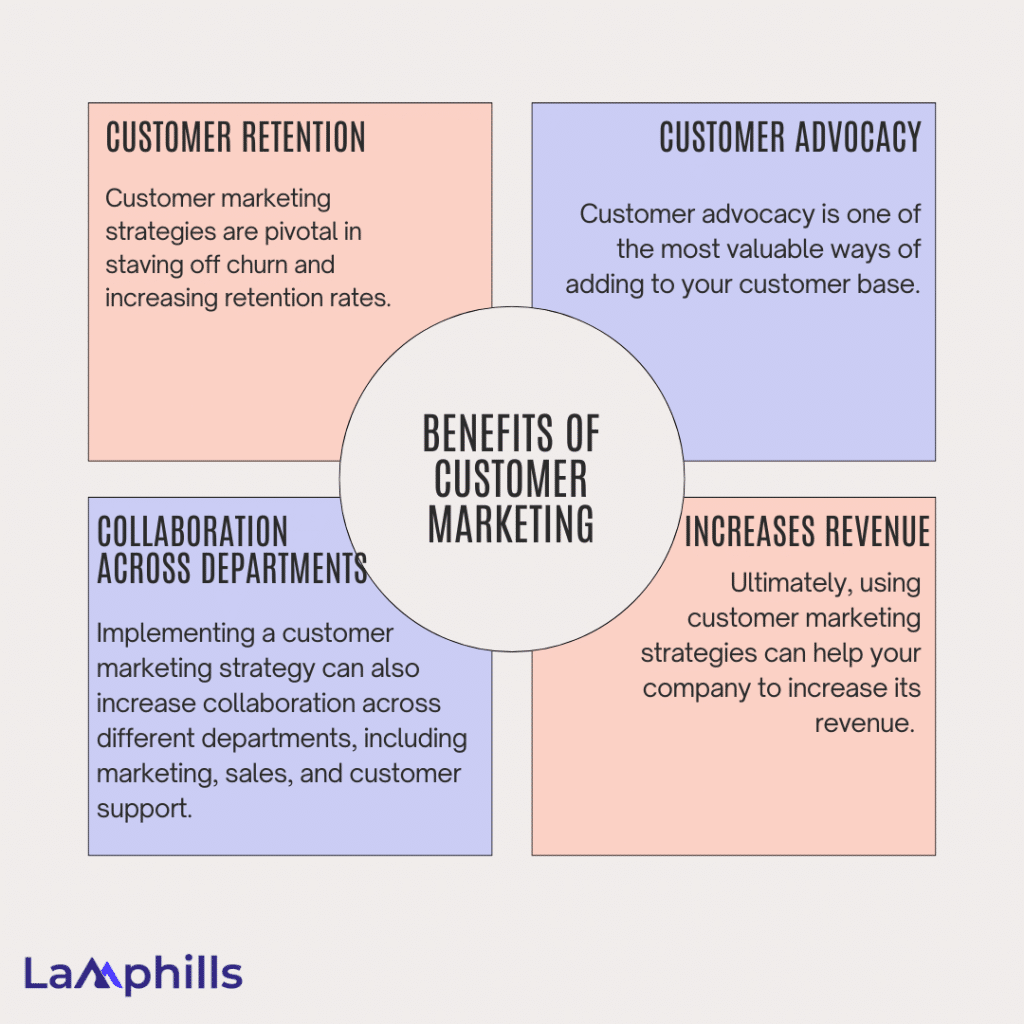
Irrespective of how you may define customer marketing, it’s clear to see why many companies adhere to its fundamental principles, with a string of benefits including:
#1. Customer Retention
Customer marketing strategies are pivotal in staving off churn and increasing retention rates. If a customer marketing strategy is executed well (i.e., your product messaging hits the right spots, they’re engaged, and your relationship’s watertight), then why would they go elsewhere?
The longer your customer uses your product, the more reluctant they’ll be to sever ties – and that’s great news for company revenue.
Why is customer retention important?
Customer retention is important because the cost of attracting new customers surpasses that of retaining existing clientele. Furthermore, when you maintain your existing customers and work with people who are vested in your brand, your product is more likely to grow via word-of-mouth marketing, and they’re likely to be more receptive to becoming brand ambassadors.
#2. Customer Advocacy
Customer advocacy is one of the most valuable ways of adding to your customer base. There’s every chance you could land additional business through recommendations or referrals.
When a customer sings your praises and shout how good your product is from the rooftops, they effectively do the hard work for you, offering their respective networks authentic, reliable feedback
#3. Collaboration Across Departments
Implementing a customer marketing strategy can also increase collaboration across different departments, including marketing, sales, and customer support. This can improve processes and productivity within the company and streamline the customer experience, increasing customer satisfaction.
#4. Increases Revenue
Ultimately, using customer marketing strategies can help your company to increase its revenue. By forming relationships with loyal customers, you can encourage them to support your company long-term. Additionally, you can gain new customers from other customers’ referrals, increasing revenue.
How to Build a Customer Marketing Strategy
We are deep in this topic, and this section will give you some pointers on developing a killer customer marketing strategy. Below, I have provided 8 killer customer marketing strategies for building your brand.
#1. Focus On Building up Your Customer Experience
Customer marketing is just that—marketing with your customer’s experience in mind. Studies have shown that optimizing the customer experience helps reduce customer churn and encourages repeat customers and customer advocacy.
Sure, while customer experience has been the main focus for marketers over the past few years, Marketing Charts showed that brands were most excited to increase overall customer experience in 2019—and that trend is expected to continue.
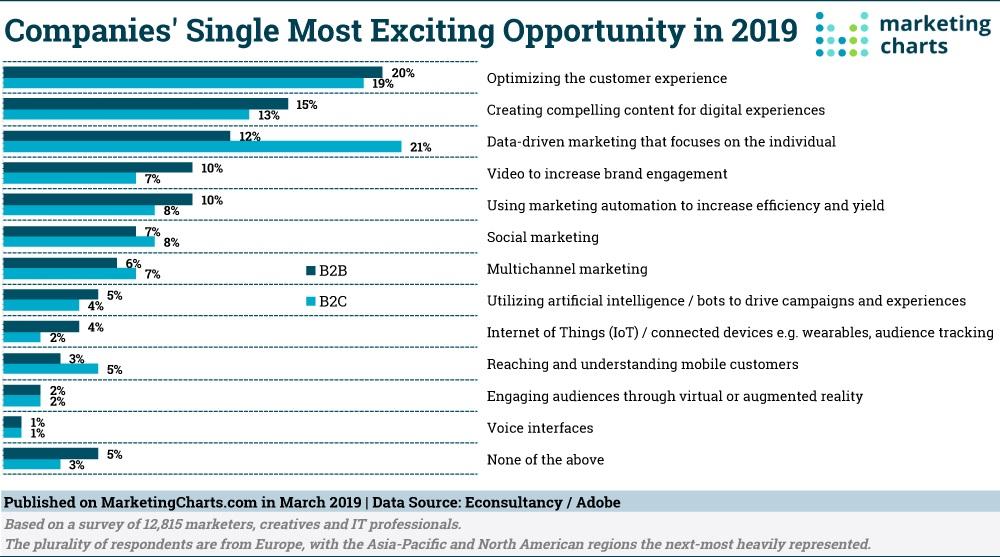
Image Source: Marketing Charts via Business 2 Community
Optimizing the customer experience can be done in several different ways, including:
- Optimizing a brand’s product or service to suit its consumers better
- Designing marketing materials for the consumers’ preferences (not for the brand’s benefit)
- Asking for consumers’ opinions and building quality relationships
Take the time to get to know your customers. After all, you can’t cater to their needs without knowing who they are and what they expect from you.
If you encourage customers to sign up for your newsletter or follow you via social media or email, a great way to get to know them is by encouraging them to fill out a preference centre. Bespoke Post does an excellent job of getting to know their customer’s email preferences:
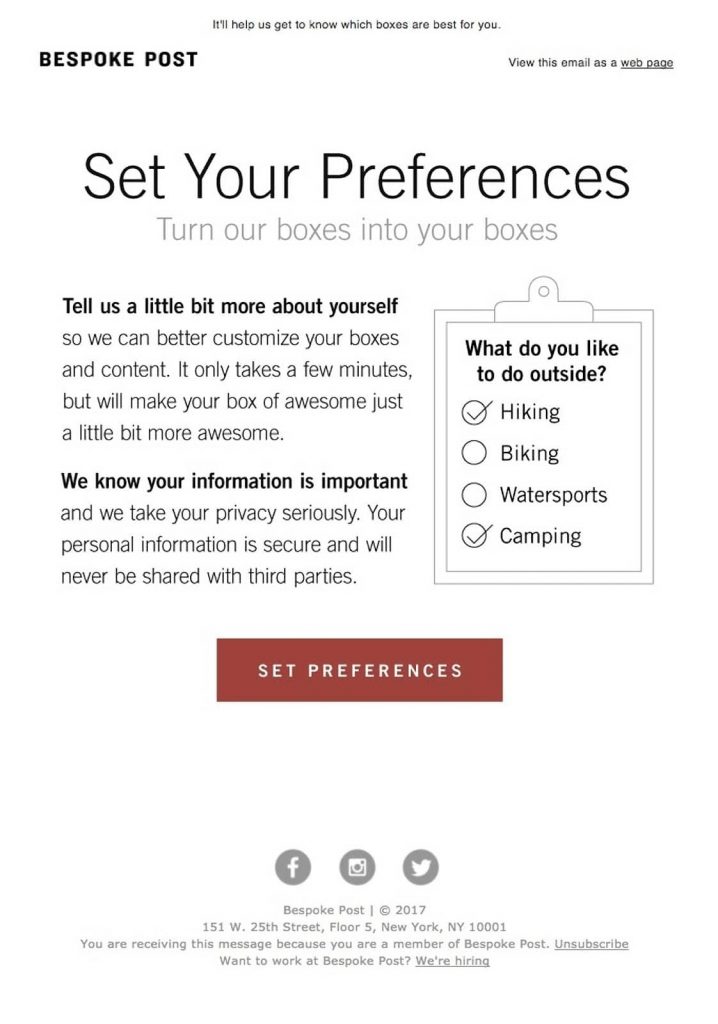
A preference centre like this lets your customers tell you exactly what they want from you.
Once this is complete, you mustn’t deviate. This is especially true for those who have opted into your email marketing list. This preference centre allows you to segment your emailing lists accordingly, so there should be little to no excuse when sending relevant content to each of your subscribers.
#2. Create Compelling Content Worth Sharing With Your Customers
Once you’ve started building your lists, it’s time to create compelling, share-worthy content. In the case of customer marketing, you want to focus on proving that you’re trustworthy and an authority and providing content that your existing customer base will find helpful. This can come in many different forms, such as:
- Industry infographics
- Case studies
- eBooks
- White papers
- Videos
- Checklists
- Interviews with industry experts or members of your company
The content you’re sharing should be helpful for those who have yet to purchase and educational for those who have. Remember, customer marketing doesn’t end with the initial purchase. You want to continue being informative in their professional lives to encourage repeat purchases and customer advocacy.
Interface Lovers does a fantastic job of creating content worthy of customers, no matter what stage of their journey they may be in.
They include links to new interviews and suggestions for playlists that their followers can listen to for extra inspiration.
Current customers will enjoy listening to interviews with industry experts. But those who haven’t yet made their initial investment will see this content as authoritative, encouraging them to invest in a relationship with you.
#3. Share Your Content
Content is critical to the success of your customer marketing strategy. Why? Content marketing costs 62% less than traditional marketing and generates about three times as many leads, but 61% of consumers said they’re influenced by customer content (content relevant to them and their needs).
However, having the best content available means nothing if you aren’t sharing it with your audience. While traditional marketing channels are viable, they don’t perform nearly as well as digital ones, especially email marketing.
Email marketing remains the number one spot regarding the highest-performing channels and the best overall return on investment (R.O.I.). Not only does it bring in the highest overall ROI ($38 for every $1 spent), but it’s also the preferred method of communication between the consumer and their favourite brands.

Again, customer marketing—even via email—is to provide your customers with interesting and relevant information. So, ensure your content is in line with what they want. Again, this is why email list segmentation is so important.
One excellent example of a brand that prioritizes customers’ needs is Airbnb. Once a customer has booked something, Airbnb sends them an email to help improve their overall travel experience (which also improves their customer experience).
#4. Become a Better Listener
Could customer marketing be as simple as hitting “Reply?”
Sometimes, yes.
Responding to comments, social posts, and emails promptly is a (relatively) easy way of doing customer marketing. According to a WebPunch study on customer feedback, 54% of customers want some form of acknowledgment from a manager or a simple response. After all, you’re showing your investment in your customers’ long-term success through your willingness to communicate with them.
Rather than leave them hanging, a swift response shows that you’re there for them.
We’re not necessarily talking about providing customer service, either. The simple act of saying “thanks” or responding to a shout-out shows that you’re listening, as shown by this reply tweet from Airbnb.

Listening also means asking your customers for feedback from time to time, whether it’s through social or email. Here’s an example of Evernote picking their customers’ brains on Twitter:
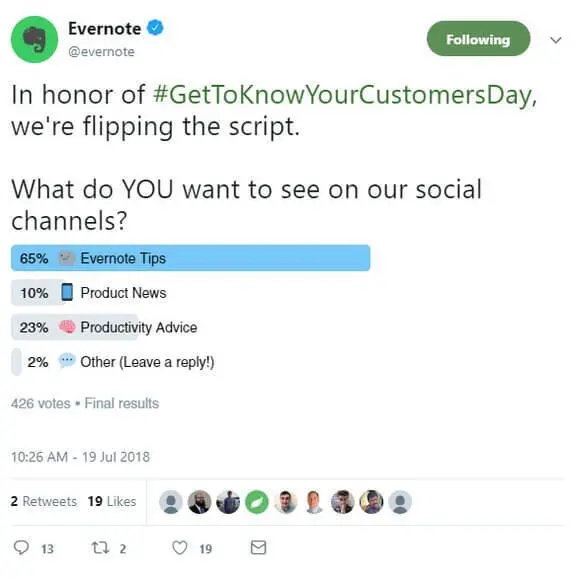
These touch points might not seem like much, but they reinforce your positive customer relationship.
Besides, it’s so easy to stay in touch with customers through social and email that there’s no reason to leave them hanging. If you can spare a few seconds, hit that Reply button.
#5. Incentivize Loyalty
Sustaining—if not consistently improving—impressive customer retention needs to be at the heart of your customer-driven marketing efforts. Your customers must be loyal if you want to sell them new products or keep them on board as long as possible. But how can you help develop and foster that kind of loyalty?
The two prior points—providing exceptional customer service and engaging with your customers—are significant parts of that process. But there are certain programs and strategies you can implement to give your efforts to promote customer loyalty a little extra oomph.
Customer loyalty programs — incentivizing long-term business with current customers through avenues like offering free merchandise, rewards, coupons, or even advanced released products — are always worth considering when it comes to customer marketing.
Give your customers tangible, immediate reasons to remain loyal. Again, this point ties into the overarching theme this article keeps touching on — letting customers know you care.
The customers who have remained with your business want to know they’re not being taken for granted. And newer customers could always use a few extra reasons to plan on staying with you in the long run.
Customer loyalty programs are a better, more straightforward way to supplement an effective customer-driven marketing strategy. So, no matter the nature of your business, consider incorporating one into your customer marketing efforts.
#6. When in Doubt, Dig into Your Data
If you’re struggling to understand what your customers want regarding offers or education, look no further than your CRM data.
Here’s some food for thought: 81% of consumers crave personalization and wish businesses knew more about them and their specific needs.
In short, segmenting your content via data is a solid starting point when you’re trying to do customer marketing that feels more personal. Your CRM can help you do exactly that.
With your CRM’s sales analytics or reporting feature, you can identify top customer needs and sales insights and get an overall picture of your business performance.
Here are a few ways that you can use your CRM to identify opportunities for customer marketing:
Solve pipeline issues: If you’re a SaaS business, is there a month or time of engagement where customers commonly cancel? Say you see a trend of customers cancelling their subscription after six months. Can you adjust your customer marketing communications to address that?
Increase average order value: Say you’re an e-commerce or retail business. How often do customers purchase from you? What about seasonality? Identifying purchase trends with your current customers can help you identify ways to market to them and increase average order value, increasing your profits over time.
#7. Deliver Your Content Consistently
Regarding customer marketing, half the battle is the act of showing up.
Producing content. Coming up with new offers and deals. Sending an email newsletter. Set follow-ups in your CRM to check in with customers regularly.
Remember that your customers’ attention is valuable, and they can support only so many brands simultaneously. You’ll always stay fresh in their minds by consistently delivering value to them.
Also, there’s no need to be shy when offering content—if what you’re sending is relevant. Using an A.I. writing generator to help you brainstorm and draft content is okay.
According to a recent Square survey, consumers want to hear more from brands and businesses through content, deals, and advice.
#8. Ask for Customer Feedback
Finally, when developing your customer marketing strategy, ensure it truly benefits your customers by communicating with them.
Asking them a few minutes to answer a customer feedback survey is all it takes.

This can be done through any digital marketing channel, including social media. However, the best way to reach your customers is through their inbox. An email message is five times more likely to be seen than a Facebook message (whether it’s a direct message or in a news feed). So, take the time to craft an email survey that allows your customer’s voice to be heard. Then, implement changes that reflect your customers’ opinions.
Customer Marketing vs Product Marketing: Difference
Customer and product marketing aren’t the same things; they’re very different.
The two have different focuses. Product marketing focuses on communicating about items purchased, their availability, and how they can fulfill customer needs. On the other hand, customer marketing uses data-driven customer- segments to market to customers effectively.
How Is Customer Marketing Better Than Other Strategies?
Customer marketing is well-known to be a more affordable marketing approach than other, less customer-centric strategies (e.g. generic brand campaigns, marketing content focused on what your company wants to talk about, and traditional advertising to large audiences).
Return on investment (R.O.I.) for customer marketing activities is much higher than for more generalist and less-targeted marketing.
Keeping your current customers and increasing their spending is a proven way of growing your business without a massive investment. Similarly, using brand advocates to promote your products and services is more effective and cheaper than traditional advertising.
Affordability can also have a downside; customer marketing managers are often allocated a smaller budget than is ideal. In these circumstances, marketing managers need to find affordable solutions for their customer marketing efforts, which not only provide significant growth. Still, they are also more cost-effective and efficient to implement in the first place.
Check out our customer marketer job description template below:
Lamphills Customer Marketer Job Description Template
How Can Customer Marketing Sustain Business Growth?
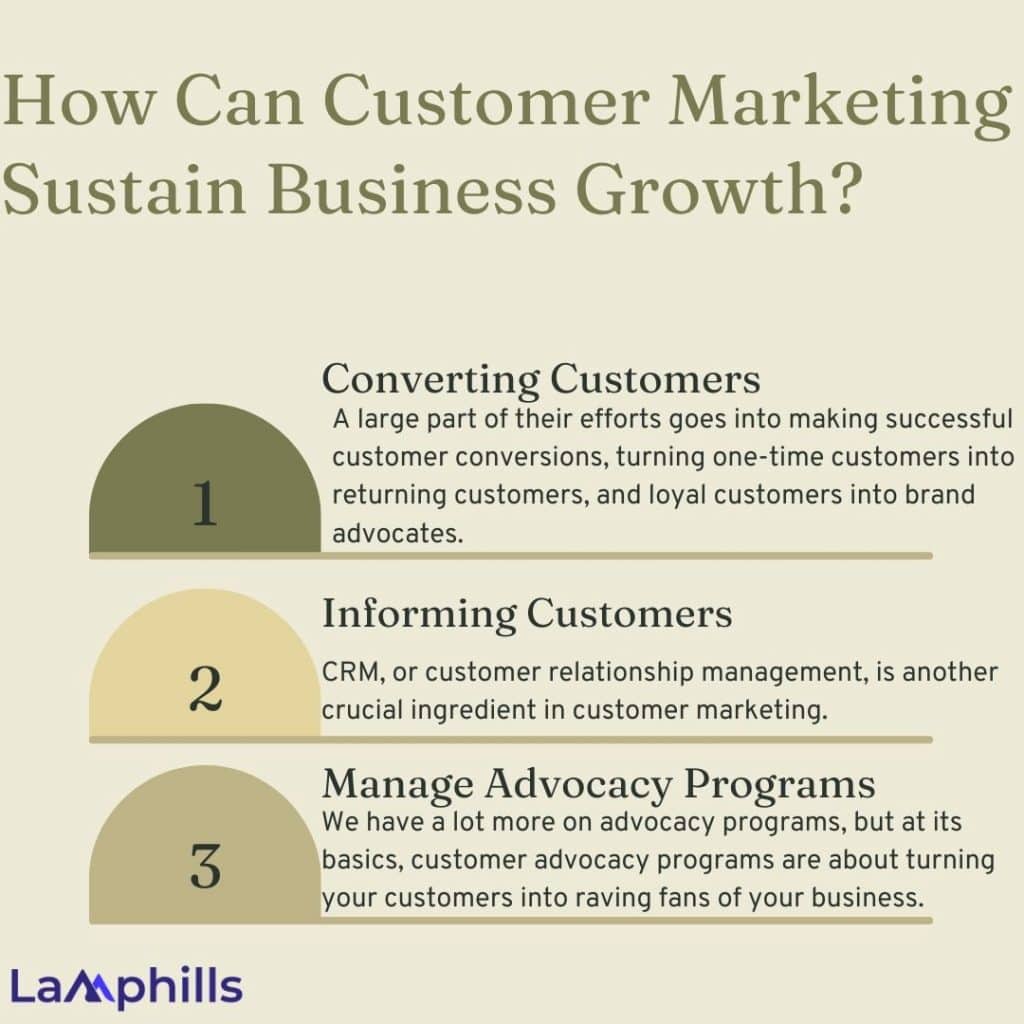
While dedicated teams manage most of the customer journey, customer marketing addresses an area most often neglected by businesses: existing and loyal customers. There’s a misconception that loyal customers don’t need as much attention or dedicated resources as new or churning customers, but that’s not true.
A lot of the customer marketer’s job revolves around improving sustainable growth for your business in terms of size and revenue. Existing customers are also a valuable source of information that can help elevate other marketing departments.
#1. Converting Customers
A large part of their efforts goes into making successful customer conversions, turning one-time customers into returning customers, and loyal customers into brand advocates.
One such task is taking advantage of cross-sell and upsell opportunities. This refers to advertising either a different product or an upgraded version of your product to your existing customers based on their purchase trends and habits.
The aim is to not come off as too ‘sales-y’ and put your customers off.
#2. Informing Customers
CRM, or customer relationship management, is another crucial ingredient in customer marketing. It is a strategy for improving how customers interact with and experience your brand. There are many ways to do this, and it’s a part of marketing that overlaps with other departments, such as customer success. CRM can be done through customer support by collecting customer feedback.
Customer marketers use this data to monitor customer satisfaction and improve the overall experience, using surveys, focus groups, and customer interviews.
Another way to improve customer-business relationships is by informing your customers of your product through content marketing. This gives your customers access to learn how to use your product effectively. This reduces the chance of customers churning out of the customer journey if a learning curve comes with using your services and gets them invested in your brand.
#3. Manage Advocacy Programs
We have a lot more on advocacy programs, but at its basics, customer advocacy programs are about turning your customers into raving fans of your business. This goes a long way to helping customer acquisition, which companies tend to prioritize. Advocates are the ones who support and promote your business for you. They can be vital in getting referrals and are good sources for promoting social proof by participating in case studies and testimonials.
Bottom Line
No matter how you look at it, businesses today need a strategy to encourage long-term customers. Beyond just producing positive business results, creating a sense of advocacy and that warm fuzzy feeling will help keep people around you for the long haul.
The good news? You already have a vast amount of customer information at your fingertips. The more you utilize your CRM, the better you know your base and the easier customer marketing becomes.
Similar Articles
- Proven SaaS Content Marketing Tactics for Boosting Engagement and Conversions
- Branded Content Marketing: The Powerful Strategy Big Brands Don’t Want You to Know
- The Essentials of Buzz Marketing: What It Is and How It Worked for Me (Best Strategies)
- Content Marketing for Startups: Growth Hacking Secrets for Explosive Traffic






